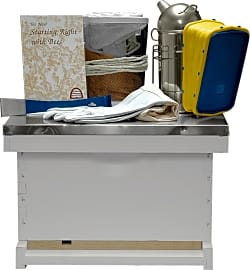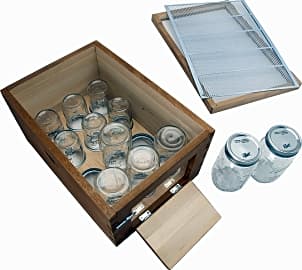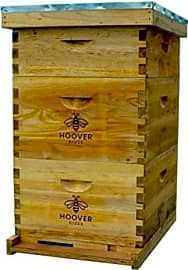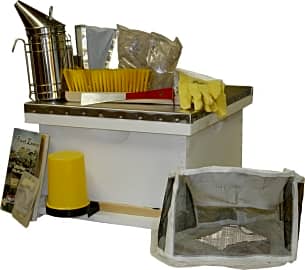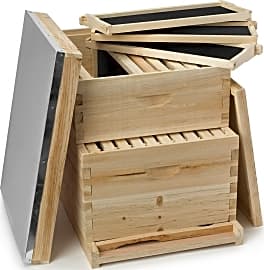The 9 Best Bee Hive Kits

This wiki has been updated 36 times since it was first published in February of 2016. Over the past decade or so, bees have been dying all over the world at an alarming rate. You can be part of the solution with one of these bee hive kits, which allow you to start your own colony and not just collect an ample supply of delicious, golden honey, but also harvest beeswax and royal jelly, or simply let the little buzzers pollinate your orchard, farm or garden. When users buy our independently chosen editorial recommendations, we may earn commissions to help fund the Wiki.
Editor's Notes
March 30, 2020:
During this round of updates, while the BuildaBeehive Deluxe Starter Kit, BestEquip Auto Flow and the Flow Classic were all removed due to availability issues, we did add several new additions to our rankings, including the Buzzing Rooster Warre – a Warre-style offering that weighs 65 pounds empty and arrives unfinished, the SummerHawk Ranch Jar Super – a Langstroth super that encourages bees to build honeycombs right inside ready-to-harvest mason jars, and the Flow Hive 2 – the latest iteration of the Australian innovation that’s seriously simplified the extraction process for many farmers over the past few years.
If this is your first hive purchase, and you’re not sure where to begin, there’s three basic types of hive that you should be aware of:
Langstroth: Invented by Lorenzo Langstroth and patented in 1852, Langstroth hives are the most popular style of hive in North America. Comprised of several boxes stacked onto one another, Langstroth hives are built using standardized sizing, so boxes from different manufacturers tend to be interchangeable. The boxes are available in shallow, medium and deep depths, and eight-frame or 10-frame widths. All boxes are rectangular.
Typically, one or two deep boxes are used as the foundation for the hive, and this is where the queen and brood live. An excluder screen prevents the queen from entering the medium boxes stacked on top of the brood box, which are referred to as supers, and these boxes are dedicated to generating harvestable honey. As these boxes can be quite heavy when full, some farmers prefer to use shallow boxes in lieu of medium. A full deep box can weight up to 90 pounds, and a full medium box can weigh up to 60 pounds.
Warre: Warre hives are similar to Langstroth hives in that they’re both vertical systems that used standardized sizing, but they do have some differences. Warre hives, which were invented early in the twentieth century by Emile Warre, are square, compared to the Langstroth's rectangular shape, which helps mitigate the footprint of your hives and keep your supers light, but leaves less potential real estate for bees to fill with honey.
Two more major differences are that Warre hives tend not to use screens on their frames, leaving bees to build their honeycombs from scratch. Also, in an effort to replicate nature's design, the queen starts in the top box of a Warre hive, and supers are added to the bottom of the hive as they’re needed – a process called nadiring – which can be quite bothersome, as it requires more heavy lifting.
Top Bar: This style is a good option for users looking to break into the hobby casually, or even users who would like to do several hives, but aren’t sure that they’re up for the heavy lifting. It’s a horizontal system that looks much like an enclosed, elevated trough. Bees are provided with screenless frames, much like in a Warre hive, and these frames can be removed directly from the hive, one by one, eschewing the need for lugging around heavy boxes. There's no standardized sizing for top bar hives, though plenty of designs are available online, if you're interested in building your own.
Special Honors
Bee Built In addition to a selection of hives, this Portland, Oregon company's website features a number of resources aimed at beginner bee keepers, like a robust blog, a sizeable book section in their online store and a series of articles to help introduce newcomers to the hobby. beebuilt.com
Morning Chores If you've got a decent skillset in carpentry, and are perhaps interested in building your hive from scratch, this article's a good place to start. It provides links to 38 detailed plans for a variety of top-bar, Warre and Langstroth hives. morningchores.com
Reasons To Own A Bee Hive Kit
While many worry over the effects of colony collapse disorder, others do something about it and acquire a bee hive kit.
There are many reasons to own a bee hive kit. Even in an urban area, the amount of reciprocity experienced from housing a colony of your own is well worth the investment. The most obvious reason to care for a bee hive is honey. Bees create honey through foraging.
The process begins when forager bees drink the nectar from flowers and then transfer it to house bees. These house bees then add enzymes to the nectar, and place the liquid into the honeycomb. Bees fan their wings to evaporate the liquid in the honey.
Once it reaches a water content of around eighteen percent, the honey is capped off with wax and stored for later use or harvested by a beekeeper. Beekeepers must be certain they only harvest honey that the bees are not using, however. Taking too much honey from a hive can cause them to die off during the winter months due to lack of food.
Pollination is also another deciding factor in owning a bee hive kit. Many plants require external pollination. Bees are the largest pollinators on the planet, moving from flower to flower collecting and distributing pollen on their hind legs.
Many people choose to own a bee hive kit to make a positive impact on their environment. Bees have a huge impact on the planet, and require little from it in return. While many worry over the effects of colony collapse disorder, others do something about it and acquire a bee hive kit. Colony collapse disorder is much less likely to happen in a private hive, as exposure to many contributing factors is limited.
The other byproducts of caring for a bee hive are fascinating as well. Things like propolis, royal jelly, and beeswax are all used in natural health products. Raw honey and hive byproducts have been used as skin care treatments, immune system boosters, antioxidants, allergy relievers, and anti-microbial agents.
How Important Are Bee Hive Kits?
Providing bees with a new home in your bee hive kit is not only beneficial to you, it protects bees as well. Colony collapse disorder, or CCD, is a worrying factor for bee hives. CCD occurs when the majority of worker bees in a colony leave behind the queen, nurse bees, and all the food in their hive. This abandonment destroys the hive and reproduction rates, and the worker bees die without a home. Colony collapse disorder is a substantial threat to humans as well, as bees pollinate around one third of global crops.
This may explain the strange behavior of abandoning a queen and all of their food, though is not the only proposed reason.
Colony collapse disorder seems to have peaked in the winter of 2006-2007, with some beekeepers reporting losing up to 90 percent of their hives in one winter. Checking agricultural records from the last century yields little evidence of past occurrences of CCD. Occasional disappearances or dying colonies have been observed for centuries, but nothing of this magnitude.
There is a link between certain pesticides like neonicotinoids and high rates of bee death. This leads many people to postulate that these pesticides cause CCD. While this cannot necessarily prove causality, it is an influential factor. Colonies exposed to neonicotinoids at high levels experience high mortality rates.
Even at sub-lethal levels, exposure to these pesticides impaired honey bees winterization process before leading to CCD. Affected bees mainly showed signs of cognitive impairment. This may explain the strange behavior of abandoning a queen and all of their food, though is not the only proposed reason. Others believe that exposure to certain environmental pesticides may increase the colony's vulnerability to varroa mites, causing them to abandon an infested hive. There are also links between bee health and certain microbes, such as the Israeli acute paralysis virus.
A regularly cleaned personal bee hive kit keeps a colony exposed to as few pathogens and pesticides as possible, and may help reduce rates of CCD from all sources.
Starting Out Right With A Bee Hive
Starting out a new hive can be a painstaking experience. The window to capture a swarm is relatively low, and bees can be picky. It is important to know how to start out right. After purchasing a bee hive kit, the largest hurdle you will come across is where to get bees. Collecting honeybees one by one will not prove fruitful, but luckily there are some tried and true ways to get bees into your hive.
When both of these options do not work, many people simply buy bees through the mail and experience great success.
The best method to start out a hive is to catch a swarm of feral bees with the help of an experienced beekeeper. Wild bees are more likely to survive, have been exposed to less medications, and are more effective pollinators than captive bees. Feral bees from the local area are also well adapted to the environment. The chance of a local wild hive encountering adversities they cannot adapt to is much lower.
If feral bees are not an option, many beekeepers experience success through using a simple bait and trap method. During the swarm season, bees are on the lookout for new places to build their hives. When both of these options do not work, many people simply buy bees through the mail and experience great success.




